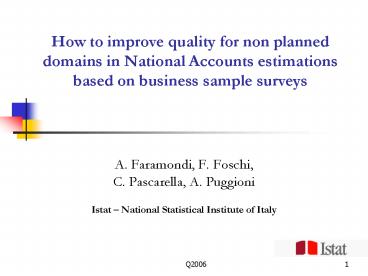How to improve quality for non planned domains in National Accounts estimations based on business sa PowerPoint PPT Presentation
1 / 21
Title: How to improve quality for non planned domains in National Accounts estimations based on business sa
1
How to improve quality for non planned domains in
National Accounts estimations based on business
sample surveys
- A. Faramondi, F. Foschi,
- C. Pascarella, A. Puggioni
- Istat National Statistical Institute of Italy
2
Estimations of National Accounts main aggregates
(1)
- In 2005 the annual National Accounts were
generally revised following the availability of
2001 census data. The aim was to accomplish ESA
95 and NACE rev.1.1. complete application. - On that occasion also estimation methods of
economic aggregates were revised.
3
Estimations of National Accounts main aggregates
(2)
- Estimations on National Accounts economic
aggregates make an extensive use of enterprise
data. - More specifically, Istat utilizes
- Structural Business Surveys carried out according
to Eurostat SBS Regulation, 58/97. - Stock Companies balance data.
- Italian Statistical Business Register (ASIA)
implemented by Istat through the integration of
sources from both inside and outside the
Institute.
4
Estimations of National Accounts main aggregates
(3)
- The estimations methods about small- and
medium-sized enterprises are analyzed - Main source Small- and Medium-sized Enteprises
sample survey. - Target estimations of economic values per person
employed in enterprises with up to 99 persons
employed. These enterprises constitute, together
with the estimation of full-time equivalent
(FTE), the basic variables for National Accounts
estimation models at current prices.
5
Estimations of National Accounts main aggregates
(4)
Main problem in National Accounts processes
figures are often analyzed and built for smaller
domains than those considered by the sampling
design of statistical surveys. Therefore
Small- and Medium-sized Enterprises Surveys do
not have planned domains for our estimations.
6
Differents estimation methods between Italian
National Accounts and the Small- and Medium-sized
Enterprises Survey
Sample survey domains are
- NACE rev. 2 FOUR digits -
NACE rev.2 THREE digits SIZE CLASS
- NACE rev.2 TWO digits - NUTS 2
while National Accounts domain
is NACE rev. 2 FOUR digits SIZE CLASS
LEGAL FORM
7
The choice of the National Accounts domains was
due to
- To assure overlapped domains with FTE estimations
- Domains adopted in previous revisions so as to
allow the backward reconstruction of accounts
time series - Statistical reasons to limit samle errors
8
The estimation method utilised up to the last
major revision completed in 2005
The Horvitz-Tompson estimator
was used where i NACE two-digits j size
class k legal form l index of the business in
the ijk domain n sample workers N target
population workers d NACE three-digits S
NACE four-digits
9
The new estimation method, based on an indirect
approach.
Nace_REV 1.1 Two-digit level
Nace_REV 1.1 Tree-digit level
Nace_REV 1.1 Four-digit level
10
Sample Size Dependent Estimator
where sample size observed in the
estimated domain population target size in
the estimated domain unknown parameter,
that indicates confidence degree about the
direct estimator
11
Sample Error Dependent Estimator
where sample size observed in the
analysed domain theoretical sample
size corresponding to a set threshold of
sample error
12
Empirical analysis (1)
In order to value the efficiency of the
different estimators we have carried out an
empirical analysis. Characteristics of the
empirical analysis - the estimators have
been applied to 1,000 sample simulations
- the sample design is the same of the small-
and medium- sized enterprises sample
surveys - the population target of
reference samples have been extracted
from is represented by active enterprises
contained in Istat Statistical Business
Register (ASIA) in the year 2000 - the
observed variable is the turnover available for
each enterprise.
13
Empirical analysis (2)
Characteristics of the empirical
analysis - the observed domains are
represented by the combination of the
following variables economic
sector (4-digit ATECO), number of
persons employed (1-2, 3-5, 6-9, 10-19, 20-99)
- we only consider non-stock companies since
information about stock companies can
be obtained from balance data derived
from census data and therefore not affected by
sample errors.
14
Empirical analysis (3)
Estimators have been defined according to the
following parameters (being those that guaranteed
the best efficiency in their respective domains)
SEDE
SSD
Nace_REV1.1 Two-digit level
Nace_REV 1.1 Tree-digit level
Nace_REV 1.1 Four-digit level
15
Empirical analysis (4)
The estimators performance has been
evaluated considering both bias and efficiency.
The estimations bias have been evaluated in terms
of Average Absolute Relative Bias
(AARB) where d generic domain
D number of domains where r generic
replication R number of replications
16
Empirical analysis (5)
The efficiency has been
evaluated by Average Relative Root Mean Square
Error (AARMSE)
17
Empirical analysis (6)
Average Absolute Relative Bias and Average
Relative Root Mean Square Error by size classes
(Turnover)
18
Integration with balances (1)
- Stock Companies account for about 10 of
small-medium-sized enterprises. - Istat acquires Stock Companies balance data
from the competent authorities items and rules
abide by EEC IV directive
19
Integration with balances (2)
- Integration is limited to the so called leading
variables detailed items are reconstructed on
the basis of the structure analysed through
survey data. - Integration allowed a reduction of total
estimation errors. The estimation of aggregates
variations from one year to the next also
improved. - However integration should be carried out very
carefully and should be assessed as against
survey results on the same domain in fact
differences in definitions among variables cannot
be completely eliminated although they are under
control.
20
Conclusions
- With respect to the previous estimation
method the adoption of the SEDE estimator and the
integration with balance data allowed a reduction
of total estimation errors - The estimation of annual aggregates
variations also improved considerably.
21
Next steps
- Increase in the number of sources utilised
(for example small enterprises tax data) in order
to test model-based estimation methods that
optimize additional information

